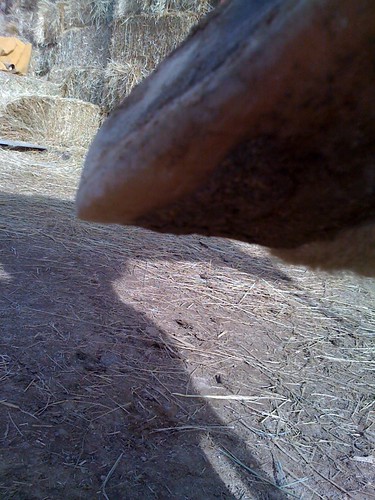I ran two little pseudo-science experiments on my mare. I don't think it's really following the scientific method if you only have one experimental subject, so I can't announce this as the reproducible truth, but it's good enough for me.
I've been intermittently confining Dixie's mane on our rides, and I thought that it does make her sweatier to have that thick wad of hair on both sides of her neck. For Saturday's ride, I braided her mane on one side, and she really didn't get very sweaty at all, despite about 15 miles of intermittent trotting. So today I left her mane loose, flopped down on both sides of her neck, and rode 7.78 miles at an average of 4.3 mph. That's .1 mph faster than the NEDA ride, and less than half as far - and she was drenched when we were done. Sweat all over her neck and chest, on her back, even her flanks were sweaty. That's good enough for me - ponytailing/braiding her mane does make a big difference in her comfort, so I'll start doing it all the time.
Second, I thought that perhaps she was gaiting better when I wasn't sitting all the way back in the saddle. She racks ok on the flat, but she hit that probably-a-running-walk going up a hill when I was leaned forward in two-point. So for today's second experiment, I stayed well forward. I actually learned three things from that! One, it kills my shoulders to ride like that. Two, she possibly gaits more - I got some really smooth pacing and step-pacing. Three, it's bad for her back. She had dry spots at the front of the saddle area. Woops. I won't do that again. I poked at them and she didn't seem to care, so I don't think I did any permanent harm to her.
I took some more pictures of her hooves. And I got a decent shot of the weird toe rocker I was talking about:

Then I accidentally learned more about it! This post on the easycare blog talks about what I'd call a foxtrot, and why the author thinks it's a good thing for endurance horses. In the section Quarter and Toe Scoops, he says:
Similarly, the toe experiences increased abrasion during the break-over and the propulsive components of support phase. High-mileage barefoot (unbooted) horses often develop a toe-scoop on their front feet: a slight depression of the hoof wall and sole at the toe between (roughly) 10 and 2 o’clock. Like the quarters, this toe scoop simply reflects an area of high wear.
That's pretty much what Lytha said and what I suspected. She's just wearing her toes off in the sand/rocks.
Hey Funder, your observations (about Dixie's back) are exactly the reasons cited when people say that "gaited horses can't do endurance." The statement is, obviously, nonsense, HOWEVER there is a grain of truth hidden within:
ReplyDeleteIn order to gait, the horse must travel with either a neutral or hollow back, rather than moving in the rounded frame beloved of dressage riders.
The more hollow the back, the more pronounced the easy gait--that's why you see Icelandics in the tolting races running with their heads way up. No horse would be comfortable carrying a rider on a hollow back like that for 100 miles.
However, as you and other gaited distance riders know, it's not all about "easy gait all the time." By mixing up the gaits that you choose to get down the trail, you allow the horse to rest some muscle groups while using others, and then changing before a particular set of muscles gets too tired. So you trot a bit, gait a bit, canter a little, and maybe walk some, and then gait for a while. By utilizing the "extra gears" built into your horse, you will keep her fresher, longer.
Yeah, the chair seat (ick) puts your weight further back and "helps" the horse hollow its back and step-pace. It's the quick way to get them to gait because (rolleyes) anything at all is better than a trot, and it's too hard to work at differentiating the gaits. (I actually sympathize - just figuring out what gait the horse is doing without a ground observer is hard, and convincing the horse to repeat it is really hard!)
ReplyDeleteMy saddle fits us pretty well, but it is a "gaited horse saddle", so it sits me a bit further back than I'd prefer. I'd really like a saddle that puts my weight closer to her withers, but the great saddle quest is so expensive! As long as this one isn't hurting her, I can deal with it.
*Dixie really does have a lot of gaits. Most of the horses I've ridden would pace for their intermediate gait, and either pace really fast or rack for their fast gait. I'm kind of making a virtue out of necessity by believing that it's good for her to use all her gears as she sees fit. I don't think I could make her slow rack for miles and miles - she's just going to swap between trot, rack, pace, and canter.
I've ridden gaited so exclusively that it seems really strange to me that most people have three gaits, no more.
Thanks for taking the pic of her foot. I *think* I've seen something similar to Farley's feet last year, but it's hard to remember- it was before I was doing her feet myself. I wonder if it has anything to do with a heel first versus toe first landing?
ReplyDelete